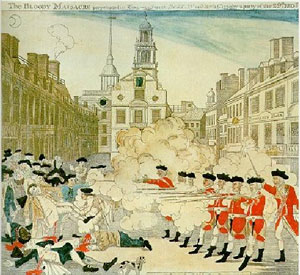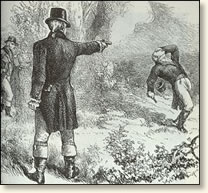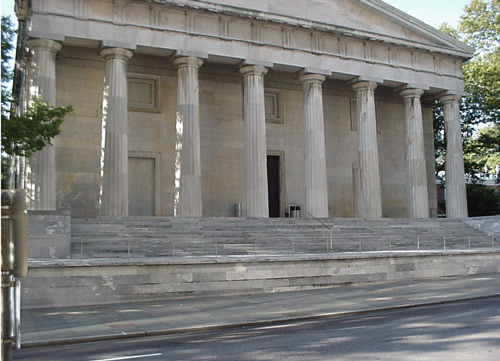
После публикации поста Bank run мне задали вопрос относительно истории финансов США в целом и Федерального Резерва в частности. Вопрос, конечно, интересный и очень трудный, так как включает в себя не просто короткий период времени, когда Федеральный Резерв был создан, а включает в себя всю историю возникновения Соединенных Штатов, как государства.
Перед тем, как приступать к рассказу, необходимо дать одно разъяснение относительно государственного устройства США, которое очень часто остается непонятным для наших граждан. Дело в том, что в основе государственного устройства США лежит принцип жесткого разделения полномочий и проводился этот принцип с одной целью - предотвратить появление доминантных сил в стране.
Для того, что бы долго не останавливаться на этом моменте, отсылаю к книге Бенджамина Франклина "Автобиография", где в истории со строительством академии описано применение этого принципа в реальной жизни.
It is to be noted that the contributions to this building being made by people of different sects, care was taken in the nomination of trustees, in whom the building and ground was to be vested, that a predominancy should not be given to any sect, lest in time that predominancy might be a means of appropriating the whole to the use of such sect, contrary to the original intention. It was therefore that one of each sect was appointed, viz., one Church-of-England man, one Presbyterian, one Baptist, one Moravian, etc., those, in case of vacancy by death, were to fill it by election from among the contributors. The Moravian happen'd not to please his colleagues, and on his death they resolved to have no other of that sect. The difficulty then was, how to avoid having two of some other sect, by means of the new choice.
Следование подобным принципам не могло не отразиться на всех сферах жизни граждан колоний и, естественно, не осталась в стороне и финансовая сфера. Учитывая тот факт, что на территории колоний в ходу была абсолютно разная валюта (французская, испанская, голландская, английская, бог-весть-вообще-какая) - это усложняло торговлю между разными частями континента из-за необходимости постоянного пересчета курсов валют при проведении сделок, курс которых, надо сказать, постоянно изменялся.
Правительство колоний не отставало от граждан и в дополнении к чеканной монете выпускало в оборот бумажные деньги, которые могли быть использованы при проведении сделок с правительством (налоги, пошлины). Курс бумажных денег из-за эмиссий очень сильно менялся, что вызывало недовольство со стороны поставщиков и крупных торговых партнеров, в первую очередь - Англии.
Вот что, в частности, писал Адам Смит про "колониальные деньги" (colonial currency)
The paper currencies of North America consisted, not in bank notes payable to the bearer on demand, but in government paper, of which the payment was not eligible till several years after it was issued; and though the colony governments paid no interest to the holders of this paper, they declared it to be, and in fact rendered it, a legal tender of payment for the full value for which it was issued. But allowing the colony security to be perfectly good, a hundred pounds payable fifteen years hence, for example, in a country where interest at six per cent, is worth little more than forty pounds ready money. To oblige a creditor, therefore, to accept of this as full payment for a debt of a hundred pounds actually paid down in ready money was an act of such violent injustice as has scarce, perhaps, been attempted by the government of any other country which pretended to be free. It bears the evident marks of having originally been, what the honest and downright Doctor Douglas assures us it was, a scheme of fraudulent debtors to cheat their creditors. The government of Pennsylvania, indeed, pretended, upon their first emission of paper money, in 1722, to render their paper of equal value with gold and silver by enacting penalties against all those who made any difference in the price of their goods when they sold them for a colony paper, and when they sold them for gold and silver; a regulation equally tyrannical, but much less effectual than that which it was meant to support. A positive law may render a shilling a legal tender for guinea, because it may direct the courts of justice to discharge the debtor who has made that tender. But no positive law can oblige a person who sells goods, and who is at liberty to sell or not to sell as he pleases, to accept of a shilling as equivalent to a guinea in the price of them. Notwithstanding any regulation of this kind, it appeared by the course of exchange with Great Britain, that a hundred pounds sterling was occasionally considered as equivalent, in some of the colonies, to a hundred and thirty pounds, and in others to so great a sum as eleven hundred pounds currency; this difference in the value arising from the difference in the quantity of paper emitted in the different colonies, and in the distance and probability of the term of its final discharge and redemption. No law, therefore, could be more equitable than the Act of Parliament so unjustly complained of in the colonies, which declared that no paper currency to be emitted there in time coming should be a legal tender of payment.
В конечном счете продолжавшаяся "вакханалия" в денежной сфере североамериканских колоний привела к тому, что правительство Англии решило навести порядок и с этой целью было принято последовательно три законодательных акта (The Currency Act, 1751, 1764, 1773), упорядочивающих оборот денег в колониях.
British merchant-creditors were very uncomfortable with this system, not only because of the obvious complexity, but because of the rapid depreciation of the notes due to regular fluctuations in the colonial economy. On September 1, 1764, Parliament passed the Currency Act, effectively assuming control of the colonial currency system. The act prohibited the issue of any new bills and the reissue of existing currency. Parliament favored a "hard currency" system based on the pound sterling, but was not inclined to regulate the colonial bills. Rather, they simply abolished them. The colonies protested vehemently against this. They suffered a trade deficit with Great Britain to begin with and argued that the shortage of hard capital would further exacerbate the situation.
Существует мнение, что попытка Великобритании взять под контроль денежное обращение в североамериканских колониях стала одной из главных причин отделения колоний от метрополии. Причина подобного недовольства объяснима - Англия могла через регулирование денежного предложения в колониях ограничивать экономическое развитие территорий.
Осенью 1774 года первый Континентальный Конгресс (Continental Congress) составил проект обращения к Англии, в котором перечислил претензии к метрополии со стороны колоний, включая пункт об ограничении торговли, хотя причин для недовольства было более чем предостаточно:
That the foundation of English liberty, and of all free government, is a right in the people to participate in their legislative council: and as the English colonists are not represented, and from their local and other circumstances, cannot properly be represented in the British parliament, they are entitled to a free and exclusive power of legislation in their several provincial legislatures, where their right of representation can alone be preserved, in all cases of taxation and internal polity, subject only to the negative of their sovereign, in such manner as has been heretofore used and accustomed: But, from the necessity of the case, and a regard to the mutual interest of both countries, we cheerfully consent to the operation of such acts of the British parliament, as are bonfide, restrained to the regulation of our external commerce, for the purpose of securing the commercial advantages of the whole empire to the mother country, and the commercial benefits of its respective members; excluding every idea of taxation internal or external, for raising a revenue on the subjects, in America, without their consent.

При этом, надо учитывать, что Конгресс созывался не для проведения отделения колоний от метрополии, а стал лишь попыткой указать на то, что Парламент Англии принимает свои решения без оглядки на мнение колонистов. Англия, в свою очередь, решила наказать слишком ретивых колонистов и направила свои войска на усмирение "бузотеров". Колонисты ответили тем, что собрали второй Континентальный Конгресс, на котором решили объединить усилия для защиты своих представительных органов власти.
Последующие военные действия вошли в историю, как Война за независимость (American Revolutionary War), по итогам которой североамериканские колонии отделились от метрополии. Но легко сказать - объявить войну, а где взять на нее деньги? Ведь колониям предстояло воевать не с рядовым противником, а с крупнейшей колониальной державой и вопрос финансирования военных действий вышел на первый план.
Считается, что помощь американским колонистам в войне против Англии оказали Франция, Испания и Голландия, чьи средства пошли на финансирование боевых действий.
The Colonial economy depended largely on foreign coins, barter, and commodity money. In 1690, the Massachusetts Bay Colony issued the first Colonial currency. Other colonies soon began to issue their own paper currency. Usually denominated in Spanish Milled Dollars, Colonial notes were also denominated in British shillings, pounds, and pence. In 1764, the British declared Colonial currency illegal. Beginning in 1775, the Continental Congress issued currency to finance the Revolutionary War. These notes, called Continentals, had no backing in gold or silver. Continentals were backed by the "anticipation" of tax revenues. Easily counterfeited and without solid backing, the notes quickly became devalued, giving rise to the phrase "not worth a Continental." This brief period marked the first time that U.S. currency's value was derived solely from its purchasing power, as it is today.
The first recorded moneys were two million livres in hard currency and war materiel. Thus, the United States currency, the Continental, was secured by Spanish silver dollars. Two additional sums were noted: the first, $74,087.00, was loaned to Patriots Oliver Pollock and Thomas Willing and, second, $174,011.00 to John Jay, United States Emissary to Spain. Another source was King Carlos III's August 17, 1780 Royal Order asking Spanish and Indian males in the Americas to donate two dollars and one dollar respectively in equivalent goods, the records of which were sent to Mexico City for distribution -- a mystery of history not quite solved, although rumors abound. Fr. Serra, Father President of Alta California, called this a "war tax." Alta California sent $4,216.00.
This clandestine assistance became open after the defeat of General Burgoyne at Saratoga in 1777, which demonstrated the possibility of British defeat in the conflict and led to French recognition of the colonies in February 1778. As a result of the victory of the Continental forces at Saratoga, Benjamin Franklin, who had gone to Paris as ambassador in 1776, was able to negotiate a Treaty of Amity and Commerce and a Treaty of Alliance with France. From this point, French support became increasingly significant. The French extended considerable financial support to the Congressional forces. France also supplied vital military arms and supplies, and loaned money to pay for their purchase.
In the field of finance, important relations were established. In 1782, Adams obtained the first loan for Congress, five million guilders, from three Amsterdam banking houses. In the latter years of the eighteenth century The Netherlands was still the money market of Europe, and the fact that Amsterdam granted the first loan to the rebels was of great help to their prestige and cause. These financial ties continued to be maintained after the independence of the colonies was recognized by the treaty of 1783. By 1794, the total amount lent by Holland had risen to thirty million guilders, or twelve million dollars. This formed the entire foreign debt of the United States
После завершения боевых действий выяснилось, что из-за неконтролируемой эмиссии стоимость американских бумажных денег упала и финансы независимых теперь колоний пришли в полное расстройство.

С целью наведения порядка в денежном обращении был образован Первый Банк Соединенных Штатов (The First Bank of the United States), идею создания которого лоббировал Александр Гамильтон (Alexander Hamilton), занимавший в то время пост министра финансов США. Конгресс разрешил создать подобный банк сроком на двенадцать лет и закрепил это в своем решении от 25 февраля 1791 года (с подробной историей банка можно ознакомиться здесь).

Организационно-правовая структура вновь созданного банка была квази-государственной и квази-частной:
The First Bank of the United States had a capital stock of $10 million, $2 million of which was subscribed by the federal government, while the remainder was subscribed by private individuals. Five of the 25 directors were appointed by the U.S. government, while the 20 others were chosen by the private investors in the Bank. The First Bank of the United States was headquartered in Philadelphia, but had branches in other major cities. The Bank performed the basic banking functions of accepting deposits, issuing bank notes, making loans and purchasing securities. It was a nationwide bank and was in fact the largest corporation in the United States. As a result of its influence, the Bank was of considerable use to both American commerce and the federal government.
Подобная идея централизованного управления финансовой политикой сразу же вызвала шквал критики со стороны оппозиции (см. разделение полномочий).
Перед тем, как перейти к обзору следующего этапа движения к единой финансовой системе, хотелось бы заострить внимание на фигурах двух видных политических деятелей США - Томасе Джефферсоне и Александре Гамильтоне. Оба политика защищали Конституцию, но при этом их взгляды на ряд вопросов расходился прямо-таки диаметрально. Так, Томас Джефферсон критиковал создание Центробанка в стране в любом виде, но выступал за приобретение у Франции территории Луизианы (Louisiana Purchase), на приобретение которой, по мнению ряда сил в стране, у него не было права.
Александр Гамильтон, в свою очередь, выступал за создание Центробанка и против приобретения земель у иностранных держав. В американском обществе по этим вопросам шла такая ожесточенная дискуссия, что иногда это приводило к печальным результатам.

Возвращаясь к обсуждению необходимо сказать, что препирательства между высокими сторонами по поводу функционирования Первого Банка США закончились тем, что Конгресс проголосовал за прекращение деятельности единого банка в 1811 году.
Проблемы с денежным обращением, однако, никуда не делись и в 1816 году был создан Второй Банк США (Second Bank of The United States) для решения все тех же задач, которые ранее пытался решить Александр Гамильтон.



Комментариев нет:
Отправить комментарий